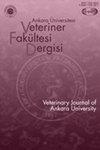Bir köpekteki post-operatif enfekte yaranın maggot debridman terapi ile tedavisi: Olgu sunumu
IF 0.9
4区 农林科学
Q3 VETERINARY SCIENCES
引用次数: 0
Abstract
Maggot debridement therapy (MDT), which lost its importance after discovering antibiotics, has recently come to the fore with the increase of antibiotic resistance. MDT, widely used in human medicine, has had limited use in veterinary medicine. The material of this case report was a 5-month-old Doberman dog that was bandaged due to a fracture of the left hind toe. It was got information that the bandage in the leg area was wet and remained on the wound for five days. As a result, the foot turned into a macerated tissue and gas gangrene was formed. The gangrenous foot area was amputated from the upper 1/3 of the femur. After surgery the amputated area became an infected wound and did not respond to antibiotic therapy. The research was planned to investigate the efficacy of MDT on an infected wound. For this purpose, the sterile first and second instar larvae of Lucilia sericata were used. The first MDT administration was done six days after the amputation procedure. The second maggot application was repeated after 24 hours, and the other two applications were repeated 48 hours intervals. After the first application, it was observed that the amount of discharge gradually decreased in the wound, and rapid healing was detected in the amputation area. The infected wound that did not respond to antibiotic treatment was successfully treated through the sterile L. sericata larvae’ characteristics, promoting wound healing. This suggests that MDT may be widely used in the future, as it is a cheap, effective, natural and easy-to-apply method.用蛆debridman疗法治疗狗的术后效果:Olga演示者
在发现抗生素后失去重要性的蛆虫清创治疗(MDT),最近随着抗生素耐药性的增加而得到重视。MDT广泛应用于人类医学,但在兽医学中的应用有限。本病例报告的材料是一只5个月大的杜宾犬,由于左后脚趾骨折而包扎。据了解,腿部部位的绷带是湿的,在伤口上贴了5天。结果,足部变成了浸渍组织,形成了气性坏疽。从股骨上1/3处切除坏疽足部。手术后,截肢区域成为感染伤口,抗生素治疗无效。本研究计划探讨MDT对感染伤口的疗效。以丝光绿蝇1龄和2龄不育幼虫为实验材料。第一次MDT治疗是在截肢手术后6天进行的。24小时后重复施用第二次蛆,另外两次施用间隔48小时。第一次应用后,观察到伤口的流量逐渐减少,截肢区愈合迅速。对抗生素治疗无效的感染创面,利用无菌丝线乳杆菌幼虫的特点,成功治疗创面,促进创面愈合。这表明MDT是一种廉价、有效、自然和易于应用的方法,在未来可能得到广泛应用。
本文章由计算机程序翻译,如有差异,请以英文原文为准。
求助全文
约1分钟内获得全文
求助全文
来源期刊
CiteScore
1.50
自引率
0.00%
发文量
44
审稿时长
6-12 weeks
期刊介绍:
Ankara Üniversitesi Veteriner Fakültesi Dergisi is one of the journals’ of Ankara University, which is the first well-established university in the Republic of Turkey. Research articles, short communications, case reports, letter to editor and invited review articles are published on all aspects of veterinary medicine and animal science. The journal is published on a quarterly since 1954 and indexing in Science Citation Index-Expanded (SCI-Exp) since April 2007.

 求助内容:
求助内容: 应助结果提醒方式:
应助结果提醒方式:


